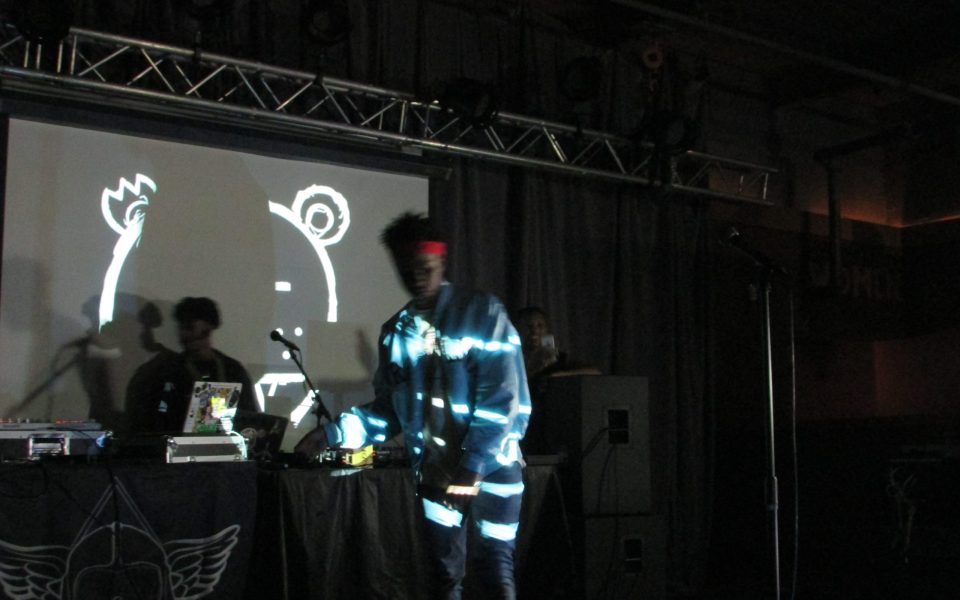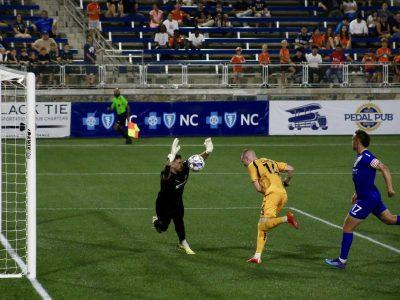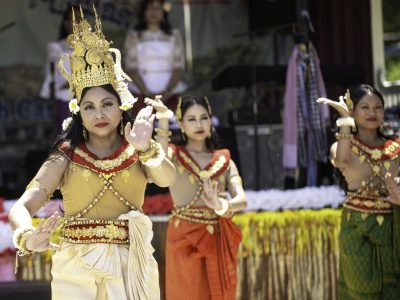by Jordan Green
The hands shooting into the air in front of the stage at the Blind Tiger to represent fans with good GPAs stood as a fair indication that this was not your ordinary hip-hop showcase.
The show of hands came as a response to an off-the-cuff digression in principal organizer Torey “Viva La Fresh” Evans’ spiel.
“If you are an artist, if you do spoken word, if you’re a fashion designer and you haven’t been on stage yet, raise you’re hand,” he said. “If you’ve got a good GPA, raise your hand. What’s your GPA? 3.5? Any 4.0s?”
Evans could be forgiven for the interjection: The third annual Black 2 Hip Hop showcase in Greensboro crammed roughly 20 acts into a five-hour block on Feb. 20, surveying some of the most vetted and promising talent from across North Carolina, ranging from slam-style, spoken-word artists to eccentric indie rappers and classic Dirty South hardcore emcees.
The GPA survey marked a pivot point from the indie segment into the hard rap finale. Will Wildfire, a Charlotte-based artist who landed a slot at South by Southwest next month, upended conventions. With a wide-brimmed straw hat covering an unruly pile of dreadlocks and dressed in a green army jacket, he treated the audience at the Blind Tinger to raw, sometimes profanity-laden R&B vocals, while bashing out chords on an electric guitar almost punk-rock style.
Wildfire’s set was received with earnest applause, but the artist who followed clearly felt the need to ramp up the energy level in the room.
Tange Lomax, an artist from High Point whose devastating flow and electric stage presence belied her diminutive physicality, remarked at the beginning of her set: “Y’all been too chill for me.”
“How many of y’all believe that your dreams are major?” she asked before lifting the audience with collective affirmation: “N****, we major-major.” Running through three tracks, she dispatched spitfire raps over monster thudding beats, while stalking the stage from one side to the other and getting into people’s faces. Vigilantly guarding against any possible lapse of audience engagement, Lomax even broke from her flow once to call someone out individually. “You with the afro,” she said. “Yeah, I’m f***in’ wit’ you.”
From that point, the all-male procession of emcees went hard all the way, from Josh “Prince” Jones through Roger Benso, Austin Royale and into the finale with JK the Reaper and his crew. With DJ Rio, aka Mario Sutton, setting the floor, the MO was to get the crowd as hyped as possible.
“We about to rage in the front,” Rio warned before Royale’s set. “So if you ain’t ready to rage in this b****, move to the back.”
Whereas Lomax had leveraged aspiration to draw the audience into a collective experience, Royale tapped into shared adversity, pulling the audience together and then taking their energy and throwing it back. Someone flung a spray of water from a plastic bottle into the bouncing scrum of bodies in front of the stage.
“Austin Royale was the super rage,” Rio quipped during the final set changeover. “Now, JK the Reaper is the epic rage.”
The collective talent showcased by Black 2 Hip Hop exemplifies the age-old dilemma of North Carolina’s place in the music universe going back to the golden age of string bands in the 1920s: Its strategic location on the map lends itself to quickly absorbing outside styles while perpetually remaining in the shadow of other cultural capitals. As Viva La Fresh mused in the green room before the showcase, much of North Carolina hip-hop is influenced by the harder beats and edgier lyrics of the Southern sound based in Atlanta, while some artists here draw inspiration from the more melodic approach of Maryland hip hop.
Edward Koomson, a Greensboro recording engineer and Viva’s partner in producing Black 2 Hip Hop, agreed that Atlanta projects a strong influence over North Carolina hip hop.
“We’ve been called the Gate City for a lot of years,” he said. “We have everything here — rock, electric, EDM. In my opinion, the reason we haven’t been identified is because we’ve had so many different sounds. Everybody that goes from New York City to Florida, they go through us. North Carolina is a melting pot.”
Viva and Koomson, along with publicist Wolfgang Lisborg, are intent on changing that. This year, they winnowed down the roster to artists ready for primetime by handpicking acts that have proved themselves through exposure and recognition in outlets like XXL, the Source, the Fader and 2DopeBoyz. Similarly, Niya Wells, a Greensboro-based R&B singer-songwriter, has received airplay on the BBC.
“I’m not the smartest guy in the world, but we won’t stop until we make it,” said Viva, who developed as an understudy to Waleed Coyote on 102 JAMZ.
“I can put together an amazing show,” he added. “I can make people understand that if we come together we can do something amazing.”
If there is one artist that could be described as the “prospect” on the lineup, it would probably be Greensboro’s Micah Williams, Lisborg said.
The mellower tonality of Williams’ music suggested violet hues instead of glaring red or stark black, and when he came onstage wearing a powder-blue Carolina jacket and a Jean-Michel Basquiat T-shirt, a flock of camera phones went into the air and the female quotient near the stage rose markedly.
The strangled guitar sound buoying his signature track, “Wild Youth,” gave Williams a platform to make an instant impression. It was a party and a cautionary tale at the same time.
“Young kid, crazy world that we livin’ in,” he rapped. “No, I’m not givin’ in/ No, I’m not givin’ in/ Hey, hey, how you feelin’, kids?/ Hey, hey, how you livin’, kids?”
For his final track, Williams invited the audience onstage, where the concert turned into a happy mosh pit with an explosion of confetti.
“I’m all about having fun,” Williams said.
Join the First Amendment Society, a membership that goes directly to funding TCB‘s newsroom.
We believe that reporting can save the world.
The TCB First Amendment Society recognizes the vital role of a free, unfettered press with a bundling of local experiences designed to build community, and unique engagements with our newsroom that will help you understand, and shape, local journalism’s critical role in uplifting the people in our cities.
All revenue goes directly into the newsroom as reporters’ salaries and freelance commissions.





Leave a Reply